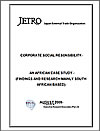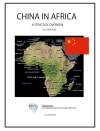 Impala Platinum Holdings Limited (IMPLATS)
Impala Platinum Holdings Limited (IMPLATS)
All data are collected in the Fiscal Year of 2008-2009.
Company Profile and History
Impala Platinum Holdings Limited (Implats) is a leading producer of platinum and associated platinum group metals (PGMs). Implats has a primary listing (IMP) on the JSE Limited and a secondary listing on the LSE (IPLA). The company may also be traded via a sponsored level 1 ADR programme (IMPUY) on the NYSE. The group is one of the most efficient and lowest cost primary platinum producers in the world.
Implats’ mining interests are found on the two most significant known platinum group mineral-bearing orebodies in the world: the Bushveld Complex in South Africa (the Leeuwkop project, Marula Platinum and Two Rivers Platinum) and the Great Dyke in Zimbabwe where Implats operates Zimplats and has an interest in Mimosa Platinum.
The group's operations on the Bushveld Complex in South Africa and the Great Dyke in Zimbabwe give it an attributable mineral resource inventory (inclusive of mineral reserves) of 237 million ounces of platinum. The Implats group has a four-pronged operational structure: managed mine-to-market operations; managed mine-to-market projects; non-managed mine-to-market operations; and Impala Refining Services (IRS).
Following a successful drilling and exploration programme in the early-mid 1960s, a mine with an initial annual production capacity of 100,000 ounces of platinum was established north of Rustenburg. The first blast was on 3 June 1967 and, in November 1968, a lease covering 27,000 acres (predominantly owned by the Bafokeng Tribe - now the Royal Bafokeng Nation) was granted for what was to become Impala Platinum, the flagship operation of the Implats group.
On the corporate side, a company called Bishopsgate Platinum Limited, of which Impala Platinum Ltd was a wholly-owned subsidiary, was listed on the JSE on 26 January 1973 and on 19 October 1978, its name was changed to Impala Platinum Holdings Limited (Implats).
In 1990, Implats acquired an effective interest in Western Platinum and Eastern Platinum (collectively Lonplats). In 1995, agreement was reached on a full merger with Lonplats although this was subsequently blocked by the European Union. In 1998, IRS was established to capitalise on Implats' surplus smelting and refining capacity.
Between 2000 and 2004, Implats acquired further mineral rights enabling it to establish Marula Platinum. It also acquired strategic stakes in Zimbabwean operations, Zimplats and Mimosa, and entered into a joint venture with the then Avmin group to develop the Two Rivers Platinum project. The stakes in Barplats and Lonplats were sold.
Black economic empowerment transactions were negotiated during 2006 and 2007. Implats finalised a deal with the Royal Bafokeng Holdings (Pty) Limited (RBH) in terms of which Impala Platinum agreed to pay the Royal Bafokeng Nation (RBN) all future royalties due to them, thus effectively discharging any further obligation to pay royalties.
In Country Location
Head office, 2 Fricker Road, Illovo, Johannesburg, South Africa;
Telephone: +27 (11) 731 9000;
Telefax: +27 (11) 731 9254
Services and Products
Implats is in the business of mining, refining and marketing of platinum group metals (PGMs), especially platinum, as well as nickel, copper and cobalt.
Impala Refining Services (IRS) uses Impala’s excess smelting and refining capacity to process the concentrate and matte produced by the various mine-to-market group operations as well as material purchased from third party companies. Toll-refining is also undertaken on behalf of other companies. Implats is one of the largest auto-catalyst recyclers in the world.
Number of Employees
48,000 employees in South Africa and 7,000 in Zimbabwe
Financial Information
Implats produced 1.91 million ounces of platinum and 3.64 million ounces of platinum group metals (PGMs) in FY2008. In FY2009 Implats produced 1.704 million ounces of platinum (3.428 million ounces of PGMs). Sales for the 2009 financial year decreased by 31 percent to R26.1 billion, from R37.6 billion in the previous period.
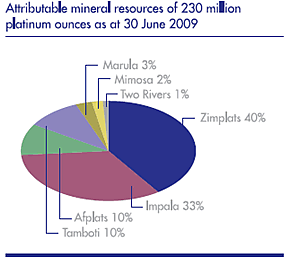
Operating statistics

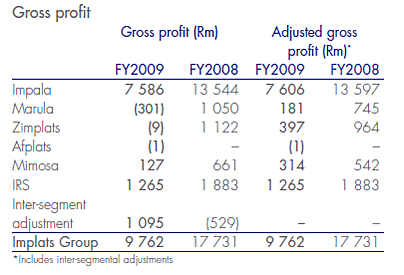
Market Share
South Africa is the world leader in platinum and PGM production, having produced around 5 million ounces of platinum and 8 million ounces of PGMs in 2007. Implats is the second largest PGM producer in South Africa and the world, supplying approximately 25 percent of global platinum output.
Business Objective
“To be the world’s best platinum producing company delivering superior returns to shareholders relative to our peers”
Business Model
“2008 saw a shift in strategic focus from growth to cash preservation through ongoing commitment to our six key strategic elements: safety, growing production and our resource base, cost- leadership, capital efficiency and delivery, improving the holistic contract with employees and managing the balance sheet. As in previous years, opportunities for growing our production and resource base will come from four key areas: exploration; organic growth; acquisitions; and recycling.
‘’Impala Refining Services, by virtue of its ability to process our organic and recycling material, remains a key source of support for the overall business-particularly from a growth perspective. We are able to leverage potential acquisitions through off-take agreements or gain exposure to any value proposition through a standalone IRS contract.
‘’We remain committed to our core philosophy of being a primary platinum group metals producing company and these metals form the basis of our long-term global strategy.
‘’The Implats Group embraces eight key strategic performance areas: Safety, Health of our People & Care for the Natural Environment; employing Exceptional Skills and Talent; meeting efficient production delivery of volumes and grades from our Mining operations is a key focus in sustaining the company’s revenue stream and profitability; the efficient and effective usage of our resources such as people, minerals, money, machinery, consumables, equipment, energy, water, information and knowledge; the alignment of growth with market demand is integral to the overall strategy of the Group. Thus maintaining strong mineral resource management and an adequate portfolio mix of organic, acquisitive, recycling and exploratory, prioritised growth options, is a focus; delivery, on time and within budget, on all our projects is essential to the future state of the Group. We will reinforce the required discipline focusing on portfolio, risk and project management to ensure on target project delivery; continue to focus on cash management as a key to preserving the financial value of the business; and our social development programmes, community engagement initiatives and government relationships remain a key focus in order to maintain sustainability into the future.”
Ownership of Business
The company’s largest single shareholder is the Royal Bafokeng Nation, which holds a 13.4 per cent stake in the group. Ninety-eight per cent of the workforce holds a three per cent stake in the group through an employee share ownership programme. Individual mines in the group also have an empowerment share holding.
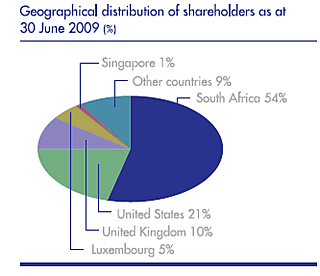
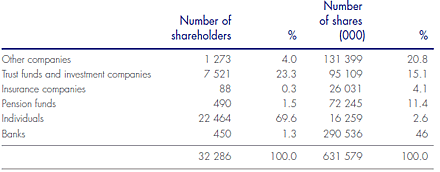
Principal subsidiaries and joint venture
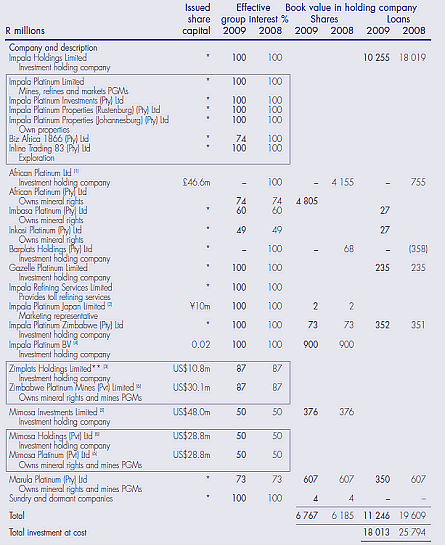
Benefits Offered and Relations with Government
The Broad-Based Socio-Economic Empowerment Charter for the South African Mining Industry was approved by the Cabinet in 2002. Targets of the Charter include 15 percent ownership of mines by historically disadvantaged South Africans within five years, 40 percent of historically disadvantaged South Africans in both junior and senior management positions in five years, 26 percent ownership within 10 years, and 10 percent participation by women within five years.
The Mineral and Petroleum Resources Development Act (MPRDA-2004) vested custodianship of all minerals in the South African State. There are four principal authorizations available under the MPRDA with respect to minerals - a reconnaissance permission, a prospecting right, a retention permit, and a mining right.
Mining companies in South Africa are taxed at the standard corporate tax rate of 28 percent. In addition, a secondary tax on companies is payable at the rate of 10 percent on the excess of dividends paid to shareholders over dividends received from other South African companies. No other tax or withholding tax is payable in respect of dividends paid to shareholders. Corporate tax is paid on all income, plus 50 percent of capital gains, less deductible operating expenditure and a capital expenditure allowance. Deductible expenditure includes rehabilitation expenditure actually incurred and annual contributions to an approved rehabilitation trust.
Prospecting and capital development expenditure is treated as follows: all prospecting and capital development expenditure is carried forward to the year of commencement of production; thereafter the accumulated prospecting expenditure and all future prospecting expenditure is allowed as a deduction either in full or in annual instalments as determined by the South African Revenue Service; in the year of commencement of production and thereafter the accumulated and future annual capital expenditure on shaft-sinking, mine equipment and mine development is deductible in full up to the amount of taxable income from mining before allowing for this capital expenditure allowance; and proceeds on the disposal of any asset previously included in the capital expenditure allowance are first deducted from any excess capital expenditure not already deducted and thereafter are included in full in taxable income. Such proceeds do not give rise to capital gains.
The South African government is currently undertaking the compulsory five year review of the Mining Charter, due to be finalized in October 2009. Meanwhile it has gazetted new Codes of Good Practice for the Minerals Industry. Furthermore the implementation of the Mineral and Petroleum Resources Royalty Act of 2008 (MPRRA) initially set to be implemented in May 2009, was postponed to March 2010 and the beneficiation strategy was launched to all representative stakeholders on 31 March 2009.
There is major dissatisfaction with the Code of Good Practices because of a lack of consultation. In addition, while the Mining Charter states that 26 percent of the mining industry should be held by BEE entities by 2015, the gazetted 2009 codes imply that the 26 percent ownership should be debt free in order to be BEE compliant and that this should occur within a two-year timeframe.
In February 2009, then Finance Minister Trevor Manuel announced in his budget speech that the implementation of the Mineral and Petroleum Resources Royalty Act of 2008 would be postponed to March 2010 in an effort to mitigate job losses in the mining industry. This Act provides that a royalty be raised on extractors of mineral resources, for the transfer of both refined and unrefined mineral resources, for the benefit of the National Revenue Fund.
Product Development
Implats has set itself the target of producing 2.3 million ounces of platinum per annum by 2012. The ramp ups to full production at Eastern Limb operations, expansions at the Zimbabwean mines, the acquisition of Afplats in early 2007, and further growth in the toll refining and recycling businesses have positioned the group for further production growth.
The R1-billion smelter expansion at Impala Platinum was completed with the commissioning of the gas-cleaning plant. Initial indications are that this plant will improve overall recoveries by around 0.5 percent. The older shafts will reach the end of their lives and be replaced by a new generation of deeper level shafts, namely 16, 17 and 20 shafts.
Number 20 shaft will commence production in FY2011 and will be followed by 16 shafts in FY2013.


